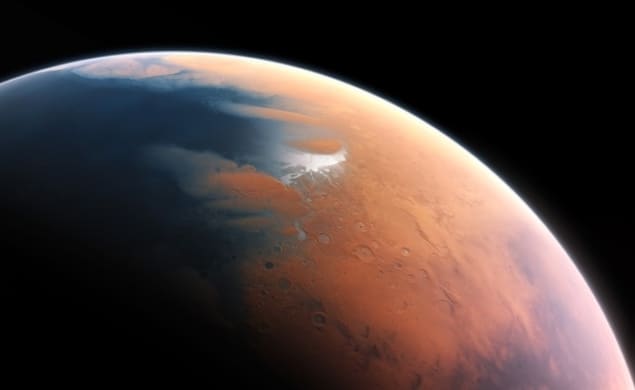Simulations show that asteroid impacts would destroy evidence for relic shorelines on Mars
30 Jun 2022
If ancient shorelines exist on Mars, they would be largely scoured from view by billions of years of asteroid impacts. That is according to a new study by researchers in the US, who used computer modelling to simulate eons of cratering on the Martian surface.
Since the 1990s, some planetary scientists have argued that certain landforms and surface features on Mars are the relic edges of dried-up oceans that covered huge swathes of the Red Planet. Their existence has been one of the central planks in the argument that vast bodies of water once sat on the planet’s northern plains, but there is still debate over whether they are genuine shorelines.
Among the most prominent features that have been proposed as shorelines are the so-called Deuteronilus and Arabia Levels, the latter of which is thought to date to roughly four billion years ago.
“The Arabia Level is older and has a higher elevation of the two, so if it is really a shoreline, it would represent a larger ocean,” explains Mark Baum, a planetary scientist at Harvard University in the US. “[While] the Deuteronilus Level may represent a considerably smaller ancient ocean.”
According to Baum, the two potential shorelines roughly follow the boundary between the two parts of what is known as the “hemispheric dichotomy” on the Martian surface – the “dichotomy” being a noticeable difference between the smooth northern regions of Mars’s globe and its cratered southern uplands.
Our study shows that it would be very difficult to observe continuous ancient shorelines [today]Mark Baum
Baum and colleagues have now used supercomputer simulations to examine what would happen to ancient shorelines, like Arabia and Deuteronilus, under the onslaught of billions of years of asteroid and comet impacts (arXiv:2206.09816). “We assume that if some part of a proposed shoreline is intersected by an impact, it would no longer be observable as a shoreline,” says Baum. “It would be obliterated by the violence of impact.”
The simulations show that some 70% of a four-billion-year-old shoreline would be erased after eons of impacts while 10–50% of a younger one – similar in age to the Deuteronilus Level – would be destroyed.
Geological signs
Elena Favaro, a planetary scientist based at the Open University in the UK, who was not involved with the new research, thinks the study “adds compelling evidence” to the body of research that questions the existence of shorelines on Mars. “There is a fair amount of scepticism within the community for relic shorelines, and the veracity of using this evidence for a global ocean,” she says.
Favaro adds, however, that there is other geological evidence for large bodies of water having existed on the planet, which includes “extensive channel and valley networks terminating at topographically low points”. These, she says, “shouldn’t be dismissed”.READ MORE

Baum says it “remains possible” that the features are indeed shorelines. “We still can’t say with certainty. At this point though, we should be very cautious with claims that they’re real,” he argues. “Our study shows that it would be very difficult to observe continuous ancient shorelines [today], especially ones that are four billion years old, which would be difficult to observe at all.”
If the Arabia and Deuteronilus Levels aren’t shorelines, it might be that they are a mix of deposits left by volcanoes, floods and Martian glaciers says Baum. “Or perhaps [they’re] simply the result of degrading lithological units along the dichotomy,” he adds. “We should send geologists there to find out.”
Will Gater is a science writer based in the UK.
from physicsworld.com 1/7/2022

Δεν υπάρχουν σχόλια:
Δημοσίευση σχολίου